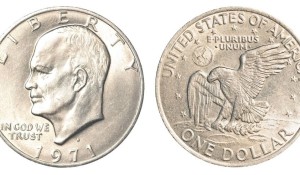Like Ike Dollars? Why High-Grade Business-Strike Eisenhower Dollars Represent Exciting Collecting Opportunities
For many coin collectors, Eisenhower dollars are a coin from "just yesterday." Yet, as of 2018, the last Eisenhower dollar will have rolled off the presses 40 years earlier, in 1978. The first issues of the Eisenhower dollar series were struck in 1971 – nearly 50 years ago. Perhaps to the pleasant surprise of many coin collectors who, unfortunately, disregard these modern coins as common in all grades and unworthy of collecting, some Eisenhower dollars are quite challenging to find in the upper uncirculated grades and are exceedingly valuable.
While proof clad Eisenhower dollars and 40% silver Eisenhower dollars in both proof and uncirculated grades are readily available in the top grades, the same cannot be said for the copper-nickel business-strike Eisenhower dollars. Unlike their numismatic-quality counterparts, which were struck with care and were specially preserved in government-issued packaging, the business-strike copper-nickel clad Eisenhower dollars were made by the millions, bagged in large sacks with little regard for surface quality, and sent off to the wilds of circulation. What many coin experts are now better understanding as we march further and further from the 1970s and the Ike dollar era is just how hard it is to find nicely preserved specimens of the circulation strikes.
Unfortunately, large, heavy coins such as the Eisenhower dollar are prone to surface marks and other forms of damage, especially when they are jostled in large sacks containing hundreds, even thousands, coins and transported across the bumpy highways and byways of North America. Today, there are few truly nice specimens left, and those that are still around are worth a pretty penny.
One of the scarcest examples of the copper-nickel business-strike Eisenhower dollars is the 1974 Philadelphia (no mintmark) issue. The Professional Coin Grading Service (PCGS) list just one surviving example in MS-67, and its value is listed as $18,500. The 1976-D Type I (minted in Denver) is also a challenging coin in MS-67. According to PCGS, only six specimens exist in PCGS-certified slabs, and they're worth around $11,500 each. Other MS-67 clad Ikes range in price from about $1,000 for 1971-D specimens in PCGS slabs to nearly $5,000 for a 1972-D dollar. Some issues, such as the 1971 Philadelphia Eisenhower dollar, are known only up to a grade of MS-66 in a PCGS slab and sell for more than $500, with none presently graded by PCGS in MS-67.
Of course, most coin collectors who are actively pursuing high-end Eisenhower dollars are in the process of building or maintaining a registry set of Ike dollars. As the number of collectors who are building Eisenhower dollar registry sets continues to grow, competition for these high-end specimens may continue to push prices upward. The greater challenge, still, may be that there are relatively few newly discovered examples of well-preserved Eisenhower dollars that reach the MS-67 grading threshold, let alone the grade of MS-68 – a virtually impossible level for Eisenhower dollars to reach.
What the future holds for the values of clad, business-strike Eisenhower dollars grading MS-65 or higher is still yet to be seen. But what collectors can take to the bank right now is that these 1970s dollar coins are fantastic collectibles worth quite possibly a lot more money than many hobbyists may think.
User comments
-
{{#owner}}
-
{{#url}}
{{#avatarSrc}}
{{name}} {{/url}} {{^url}} {{#avatar}} {{& avatar}} {{/avatar}} {{name}} {{/url}} - {{/owner}} {{#created}}
- {{created}} {{/created}}

